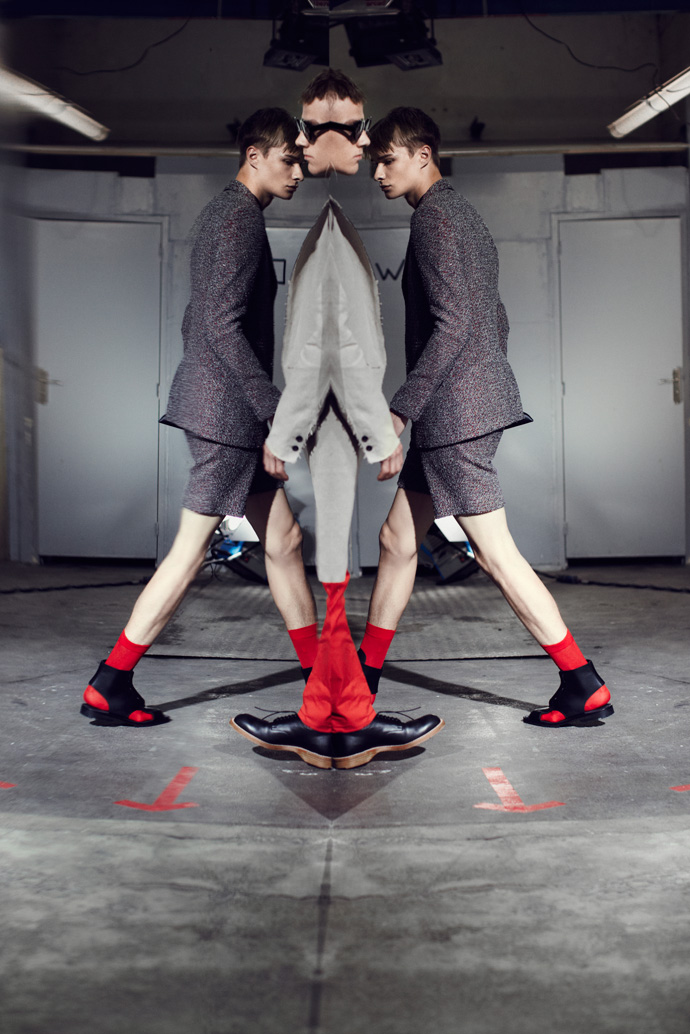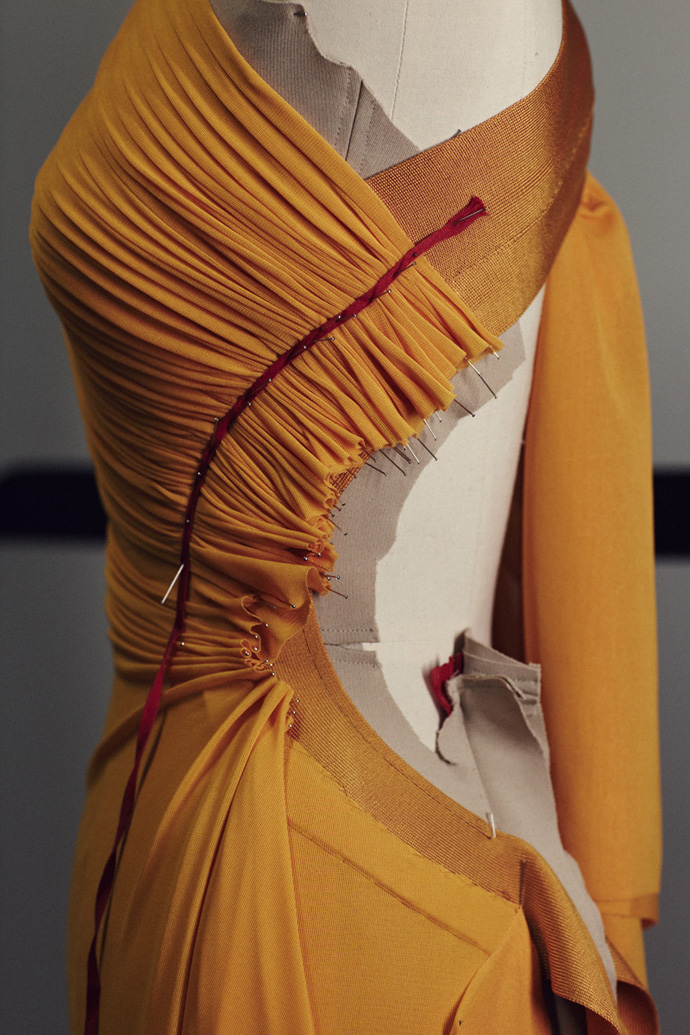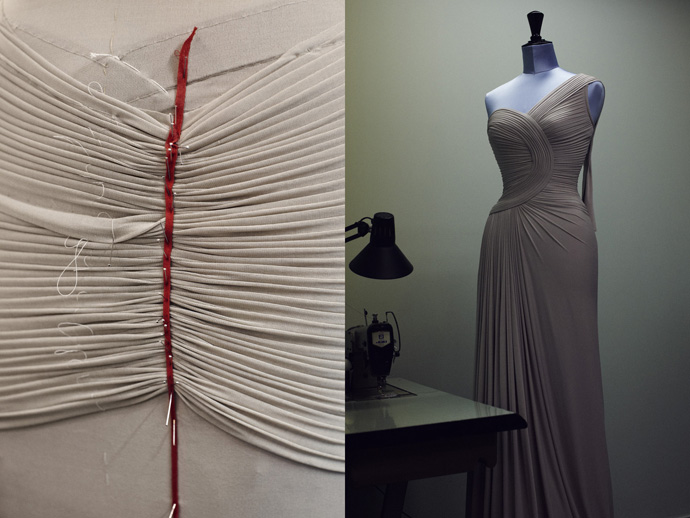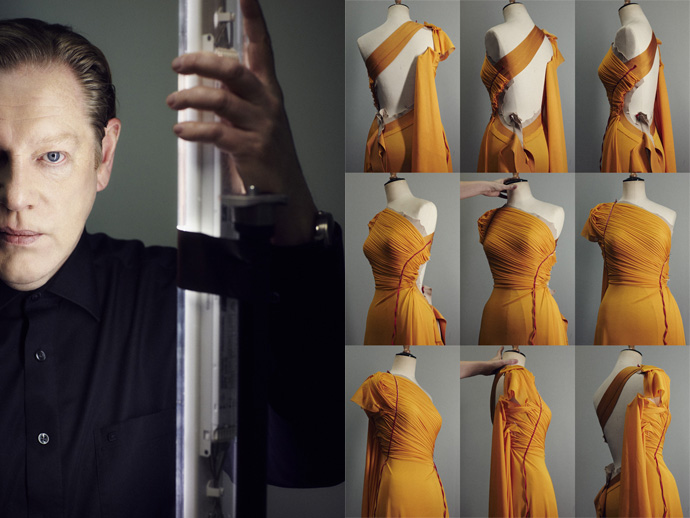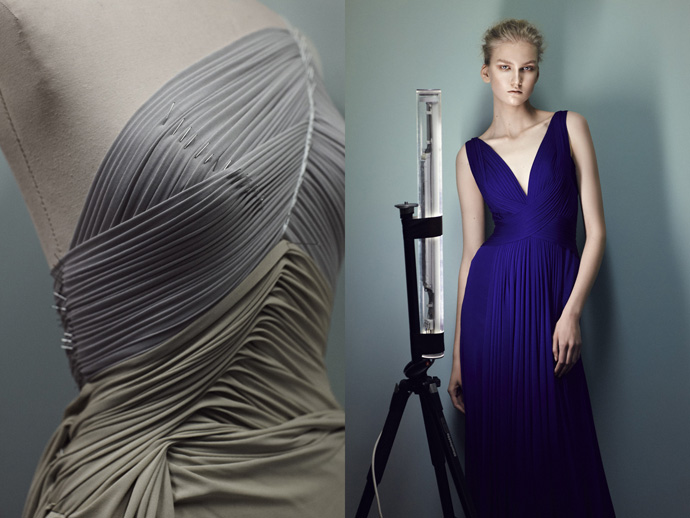-

john lawrence sullivan : in the ring
-Tokyoite Arashi Yanagawa, the man behind menswear label John Lawrence Sullivan, has quickly become a fixture of the men’s fashion circuit.
The choice of name for the label is perhaps the most telling. John Lawrence Sullivan, the man, is a heavyweight boxing champion, also known as the “Boston strong boy,” and godfather of sorts to Arashi, who quit a promising boxing career to fight in another type of ring.
Ever since entering the seasonal arena of fashion week in Paris, he’s championed his collections in the eye of attention, with the likes of Suzy Menkes a constant follower. In this context, Arashi’s unconventional vision of the sharp tailored sportsman is most compelling.
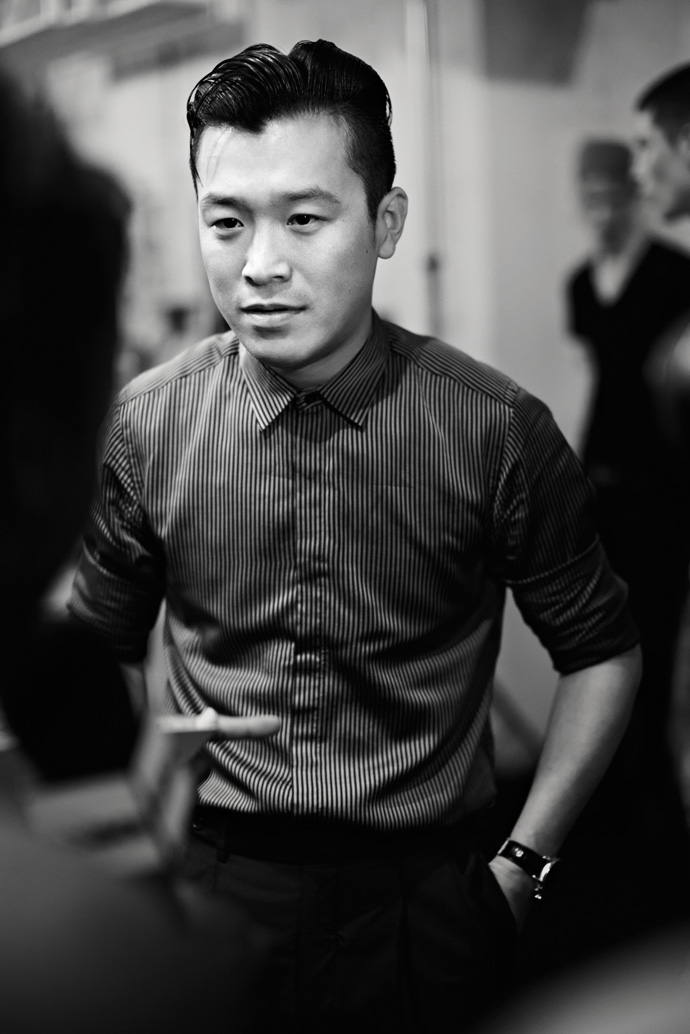 Arashi Yanagawa backstage after his John Lawrence Sullivan presentation. Photography by René Habermacher
Arashi Yanagawa backstage after his John Lawrence Sullivan presentation. Photography by René HabermacherRené Habermacher: Hello Arashi, how is it being back in Tokyo after your last show in the ring fight of Paris fashion week?
Arashi Yanagawa: I’m getting ready for the next match in June. While I’m always relaxed in the end, I also always begin thinking about the next collection right away. It’s exactly the same as in boxing.RH: In your work, specially your most recent collection, I sense a strong fascination with British culture.
but you’re successfully showing your 3rd collection, you chose Paris to present it…
AY: I believe Paris is the most important location for fashion in terms of the both the culture and the history of the industry. Paris has a special eye for beauty and elegance. No other place draws as many journalists, buyers, and fashionistas. All of this naturally makes Paris a very attractive city for presenters, but I also appreciate how strict everyone in Paris is towards creativity.RH: And what is it with you and London?
AY: London has street fashion just like Tokyo, but it also brings history and tradition into the mix. I’m impressed by the way all of this culture has just naturally rubbed off on the younger generations. Another example of something that has really moved me is the culture of the London market where you see young people today buying and even demanding clothing designed a century ago.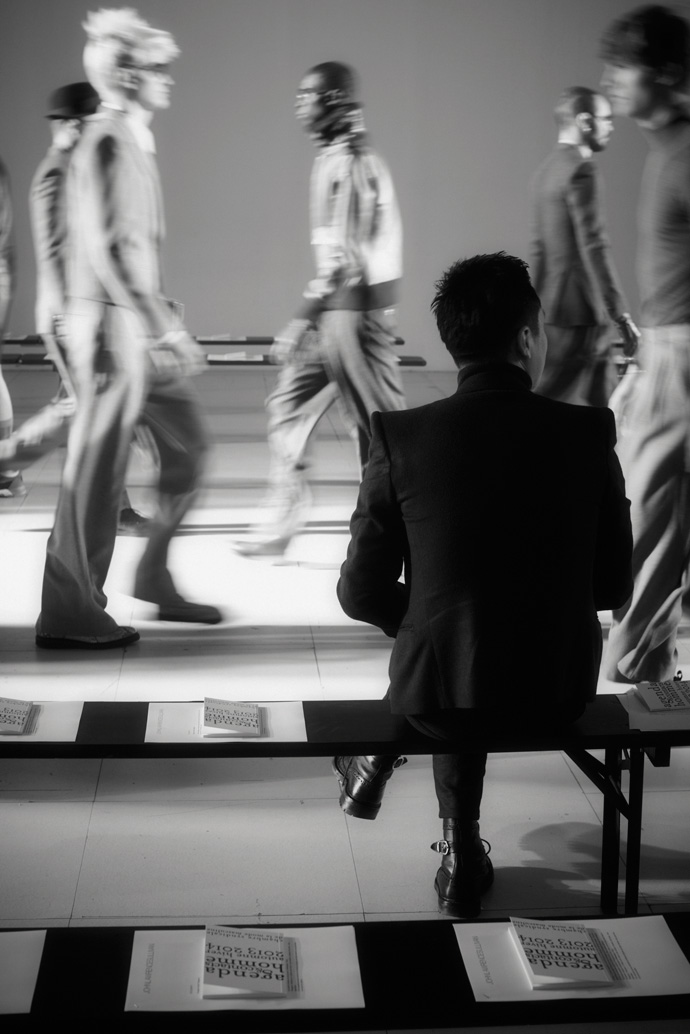
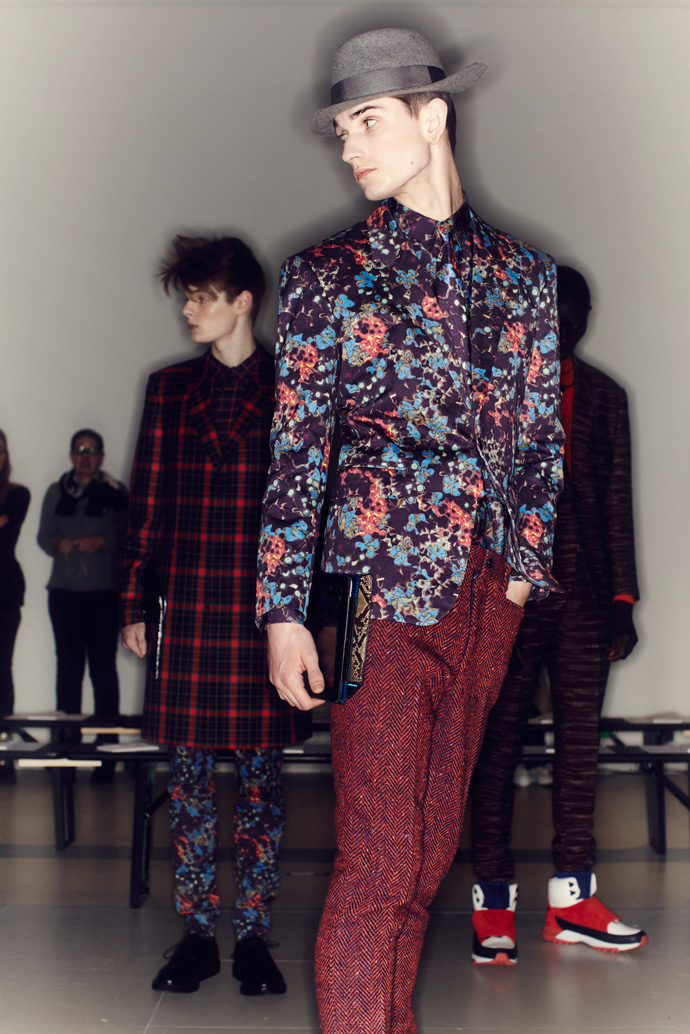 Rehearsals for John Lawrence Sullivan FW13. Photography by René Habermacher
Rehearsals for John Lawrence Sullivan FW13. Photography by René HabermacherRH: how do you decide for what you’ll go next? what is your creative process?
AY: I input the “sense” of the things I see or hear in my daily life and stockpile them. These could be colors, silhouettes, light, or even materials. But, I make an effort to express my own sense of the now rather than just making things based on historical research.RH: For the current summer collection the theme was influenced by the Bauhaus movement.
Why did you feel the urge for this now, and how did you translate that into the clothes?
AY: I had a chance to go to Berlin, so I paid a visit to the Bauhaus school in Dessau and took in the artwork there. I found the combinations of wood, leather, and metal used in the products there particularly interesting, and thought it might be fun to try doing the same things with apparel. So, I made the theme “Bauhaus” and began putting together the collection while referencing architectural cutting, artistic colors, and product techniques.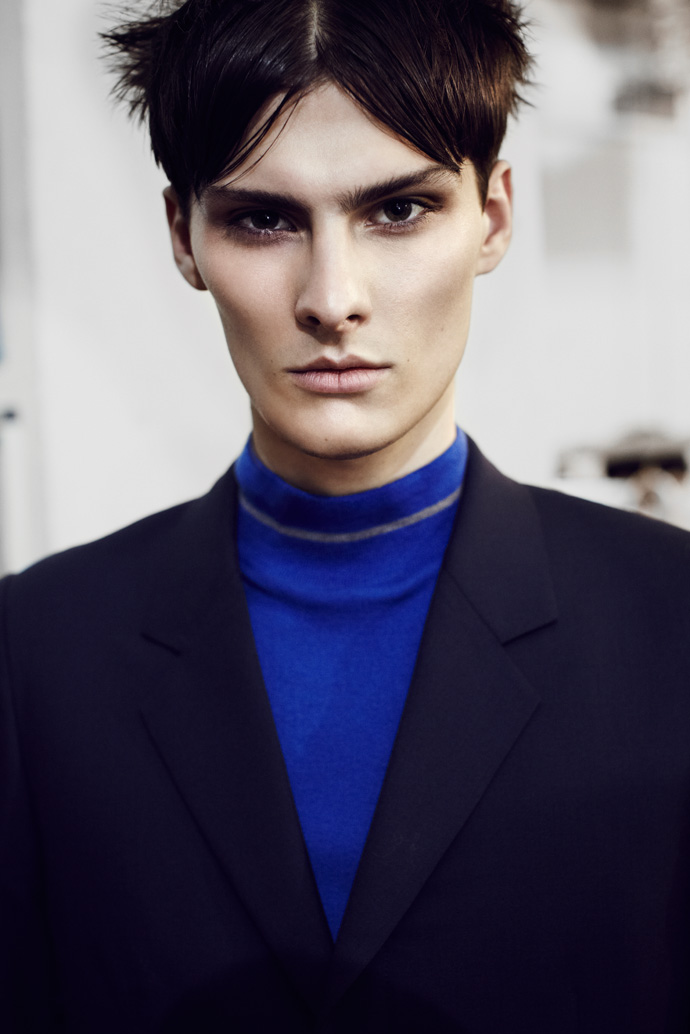
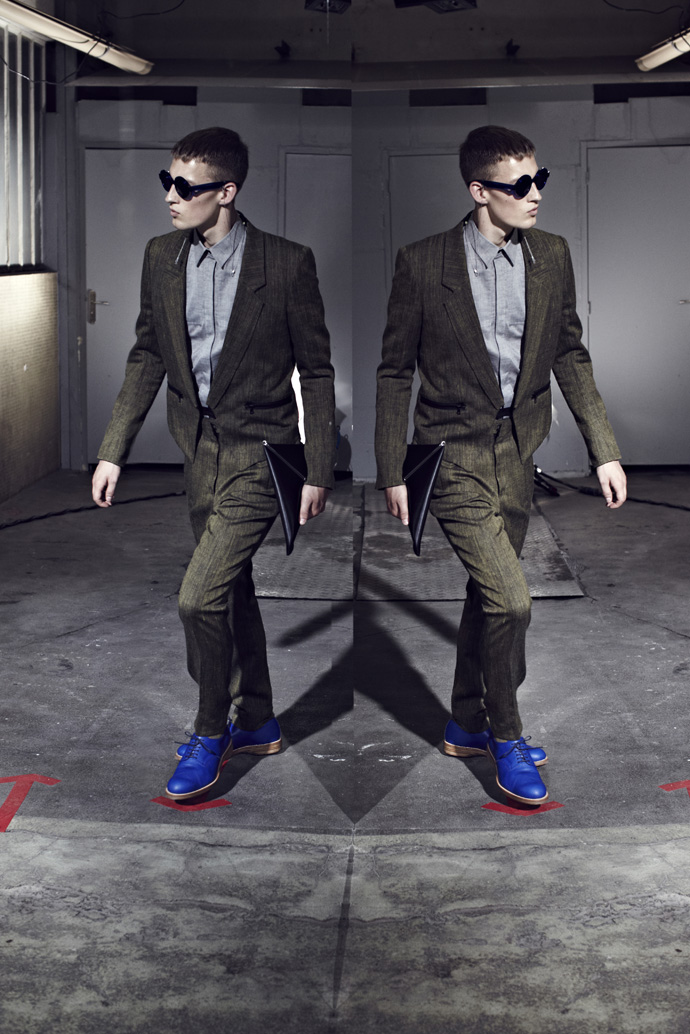 John Lawrence Sullivan's "Bauhaus" inspired collection, SS13. Photography by René Habermacher
John Lawrence Sullivan's "Bauhaus" inspired collection, SS13. Photography by René HabermacherRH: can you tell me more about “ELECTRIC AFRICA”: theme of the collection FW13/14, you just showed in Paris, what ideas are behind it?
AY: “Electric Africa” is a coined phrase. I had the idea to create a new, modern vision by combining tribal patterns associated directly with Africa with flashy colors instead of the standard earth tones. Tribal (triangular) elements were worked into various items and aspects like the cutting of the tailored jackets or the placement of the buttons. I also added a spacey essence reminiscent of the crop circles that suddenly appear in fields to the accessories, colors, and textures.RH: This collection also sports extraordinary footwear. Your sneakers have been hailed throughout. How did this design come together?
AY: I wanted create something akin to sneakers or trekking shoes, so I used Vibram soles. I also combined the base colors of the seasonwith highly contrasting hues in order to bring out a sense of Africa. I worked with a brand called ORPHIC when making the shoes.RH: Since you dropped your boxing for founding your label, fashion in Japan underwent quite some changes. How do you see the japanese approach today, what is your viewpoint and what influenced you over the course of time?
AY: When I started my brand in Tokyo my image was much more aggressive. I feel like back then many of the magazines adopted a fashionable approach, and that the buyers tried to answer the challenges the designers undertook with respect. But, as the economy got worse the magazines switched to much more easy to understand catalog-like appearance in order to make sales, which in turn influenced buyers, whose customers were influenced by this, to become much more conservative in their selections. So, there were a lot of negative things occurring in fashion here. The Tokyo runway shows were no different, as the focus shifted conspicuously to more “real” presentations rather shows with a bit a fantasy or elegance to them. Feeling all of this made me want to do my shows somewhere more stimulating, so I chose Paris.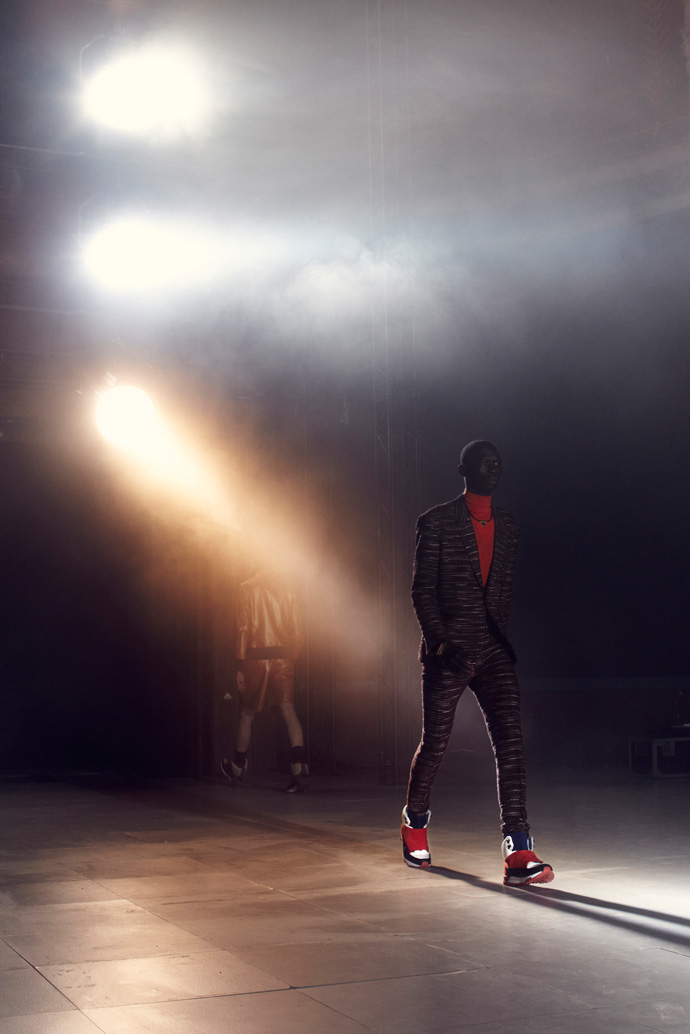
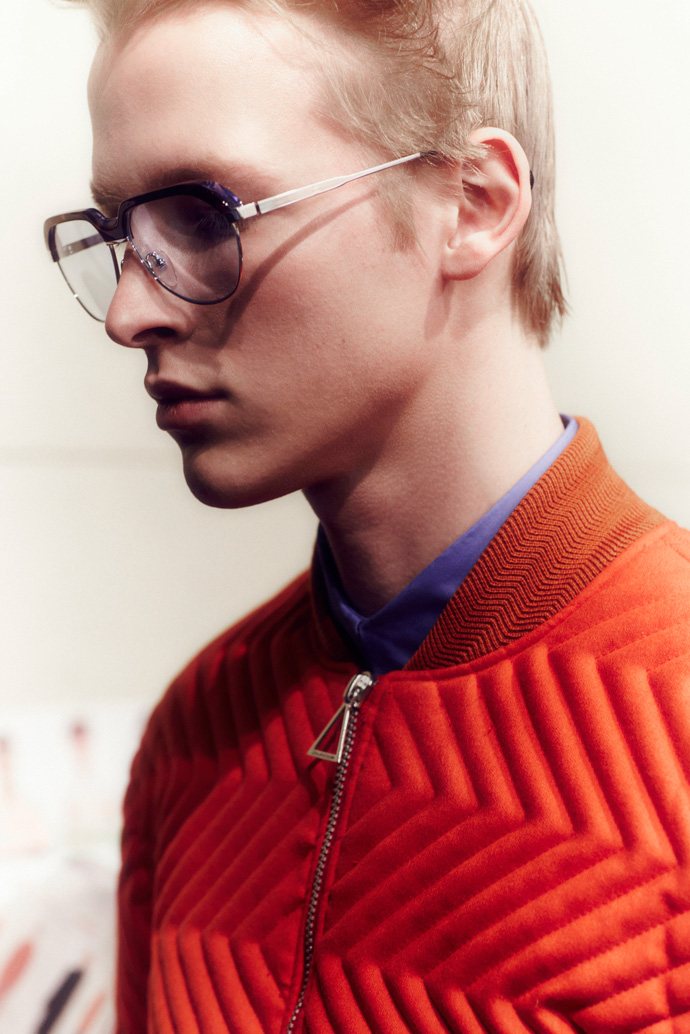 "Electric Africa", John Lawrence Sullivan FW13. Photography by René Habermacher
"Electric Africa", John Lawrence Sullivan FW13. Photography by René HabermacherRH: While developing your collection, are you having a specific type of man in the back of your head?
AY: I always imagine a man who possesses both beauty and strength in terms of appearance and mind. If I were to provide a sportsman as an example, there is a certain boxer who comes to mind…RH: Are there any parallels you can draw between your sports career and the one in fashion?
AY: One thing I realized when I first started working in fashion is that there is a common trait shared by boxing matches and fashion shows that only I seemed to notice. This was the way in which you worry over something that will last only few minutes on a single day for months in advance, battling with your anxieties and, as long as you don’t give up, preparing for the next match as soon as it’s all over regardless of whether you won or lost. The way everything seems so fleeting and transient once it’s all said and done is also the same.RH: The understanding of classic tailoring is a very strong element in your work. Now you started your women’s line: how does this apply here?
AY: Incorporating classic tailoring into women’s fashion is one of the most important elements for John Lawrence Sullivan. This isn’t something just any brand can do, so it’s something we will continue to actively working with in the future. One of the differences between men’s and women’s fashion for me was the way in which things like esthetic elements concealing points I had complexes about confused me a bit at first. Now I feel that I have learned to use men’s techniques to deal with these things.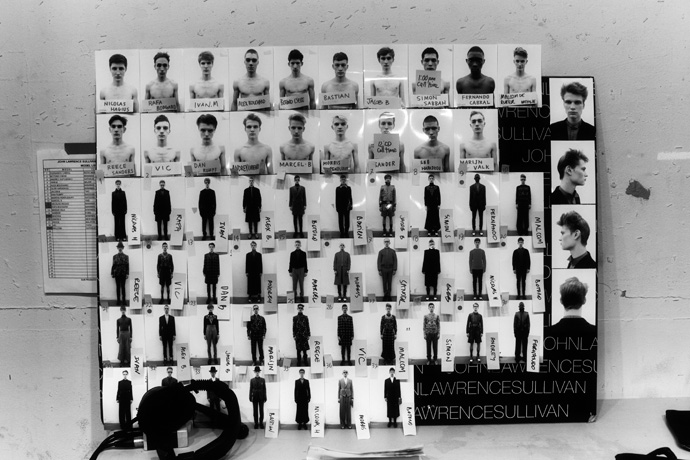 Showboard with looks and cast for "Electric Africa". Photography by René Habermacher
Showboard with looks and cast for "Electric Africa". Photography by René HabermacherRH: As you added another collection to your house – your work wheel must spin faster evidently, with 4 instead of 2 presentations.
AY: I always think of how I can break down the restrictions of the tailored look when I do my men’s designs. While there is the sense that I can be confident in breaking these restrictions down precisely because they exist, but with women’s my process is one of imposing my own restrictions on the things I design freely. So, there is a sense of mutual stimulation between my men’s and women’s lines that has been a good influence in my opinion. That said, I am definitely much busier than before…RH: Do you feel urged by the increasing numbers of pre-collections and cruise collections that the big houses lately launch?
AY: This is most likely just a sign of the conservative sales trends we’re seeing worldwide right now.The big houses are just doing this as a way of making sure they continue to pull in revenue. I too feel that JLS must do the same if we are to continue showing in Paris, so I’ll be considering various strategies for this in the days to come.RH: With clients all over the globe in different climate zones: do “season oriented” collections make still sense to you? (already the weather in Japan is quite different to the north american or european)
AY: Breaking things up by season allows designers to change up their mood and add depth to the presentation, so I most definitely think it has meaning. But, I also feel that in terms of actual sales it is often seasonless items that perform the best.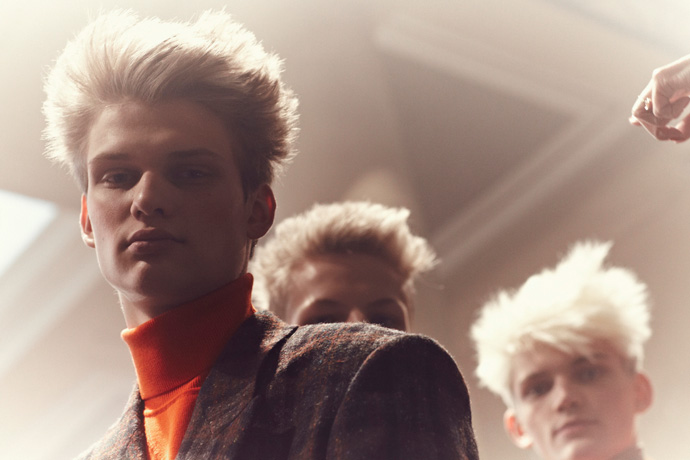 "Electric Africa", John Lawrence Sullivan FW13. Photography by René Habermacher
"Electric Africa", John Lawrence Sullivan FW13. Photography by René HabermacherRH: How do you perceive the present of fashion?
AY: I think what we are seeing is a mixture of various styles coming together.
This is also exactly why I feel that you can’t make it in this day and age unless you believe in yourself and keep making bold presentations. I guess you could say I feel we’re in an era where only the essentials survive. I want JLS to continue to be a brand that always takes up the challenge of presenting in Paris.RH: What is up next?
AY: The designs for my women’s exhibition in March and preparations for the 2014 S/S season.RH: What is the last thing you saw, read, heard or felt that stimulated you?
AY: Tadao Ando, James Turrell, Donald Judd, Taro Okamoto, Talking Heads, Pixies, David Bowie, Wes Anderson, Jim Jarmusch, Kinji FukasakuWebsite: John Lawrence Sullivan
00 -

MONSIEUR HERVÉ
-What’s in a name ?
You can ask Kenzo Takada, Martin Margiela, John Galliano, Valentino Garavani or Helmut Lang – designers who, for various reasons, left the company which bears their name, and then had to make themselves a new name, in fashion or elsewhere.
Or you can ask Monsieur Hervé Léger, the legendary French designer who took fashion by storm with his body-conscious designs, ultimately embodied by the “bandage” dresses. Monsieur Hervé Léger does not design for Hervé Léger, the company. Monsieur Hervé Léger designs for Hervé L.Leroux, a nom de mode suggested by Karl Lagerfeld.

Photography by René Habermacher
Filep Motwary, who met Monsieur Hervé through model and muse Suzanne Von Aichinger, talked with the designer as he prepared his new couture collection for Summer 2013, now on display in Paris in Colette and on presentation in Monsieur Léger’s new but history-laden atelier.
Filep Motwary: So, how is your day so far?
Mr. Hervé Léger: Well it’s cool. I am peaceful today. Yesterday I was not, but today I am.F.M: You are getting ready for your Couture collection ?
Mr.HL: Yes, you see I am a professional, I try to do everything in the right context and I do not like to keep my people working at night and we are trying to be efficient and of course we will be ready on time. You know I’ve been creating for a long time, but because I didn’t want to make shows, my comeback is under new conditions. And it figures that some people always followed me and now I sell worldwide. Business is good now finally again and I am pleased.(As we speak, Suzanne Von Aichinger and René Habermacher are working in the showroom photographing the garments),
F.M: I understand. Do you mind if you help me fill some gaps of your life’s storyline, because it’s out there, but not fully completed… So, it was during the late 1970’s that you started-off your career as a hat maker and hairdresser?
Mr.HL: (Laughs) It’s a crazy story, but… I’ll try to make it short. I had done some studies like everyone, I went as a young man to the Beaux Arts in France though I only stayed for one year as it was the 70’s and France was all about manifestations at the time and intense political changes. As students, we were on the streets demonstrating and I wasn’t learning a lot since everything was on strike.
I also wanted to be independent from my parents and wanted to do something by myself, to work. I am very good with my hands; I am a craftsman and can do everything with them in terms of creation so I decided to be a hairdresser. Although I didn’t study hair, I learnt the job very quickly by opening the door of a hair-salon telling them I wanted to learn. They took me and stayed there for a while. Then I started to make hats, after finding a book at my grandmother’s house, which was full of illustrations on how to make them. The first customers arrived and I was working at home. So there goes the “hat story”.
Then one day someone who was famous in the 1970’s asked me to do a very particular hat, a-giant-sort of “Belle Époque” hat with a lobster on it (laughs). The guy’s name was Tan Guidicelli, whom you probably might know. It wasn’t long enough until he asked me to make three dresses for his show because his atelier was very busy and his show was in three days. Although I had never designed any dresses before, I said “Ok, I’ll do them” and when he saw them he said “ you got a real sense of fashion and you should stop hairdressing and come work with me”. So that was my first fashion encounter.
Of course I dropped hairdressing and started to learn sewing. Later I went into design. My second big encounter was Karl Lagerfeld.
The 1980’s were an easy time. You could easily meet someone. People were more open. Even during my days as a hairdresser, with my friends, you could end up having dinner with Claude Montana, Mugler, Lagerfeld etc. It was not such a big deal as it is today. It was proper dinners you know, not charities. So at the time I met Karl at the house of a journalist friend and something happened immediately. We started talking about corsets (at the time I was fascinated by corsets). So that was on Saturday and on Monday my friend from “Woman’s Wear Daily” called to say “Karl wants to see you.” So I went with a few sketches and he said, “ Well, I don’t care about your sketches, I’m looking for an assistant at Fendi in Rome” and I said “Yes!”.
So by next Friday I was on the plane flying to Italy.Then I went to Chanel for one year and worked for him until I was fired.
I created my own label in 1985 but the bandage dresses came out only in early 1990’s. I don’t consider the beginning of my career started in the 80’s. My career, as I see it started in the 90’s.F.M: Tell me about the bandage dress…
Mr.HL: The real story of the bandage dress is important as a fact of my work storyline. I was having a show at Angelina Tea Salon in Paris, and I wanted something glamorous for the finale. I didn’t have the fabrics. A few days later, I went to a factory and found some bands of metallic yarn, sort of lurex. I asked, “What is this?” and I was told “its for the garbage”. So I took that and I started to put one yarn next to the other and started molding the bands on the dummy, exactly like you do hats. And that’s how the first bandage dress was born. I did the show and it was a success.
I was hooked on these new for me materials and started to experiment. In the beginning, I did not want to put any zippers because I wanted to create a dress with no seams. The problem was that I did make the dress with no seams but when one of my clients got herself in, she couldn’t get out (Laughs).
Then came the presentation of nine dresses in the office of my press attaché at the time. The fashion journalists from American Elle made pictures and became a success very quickly.
F.M: This technique you are working on, the way you make your garments is really one of its kind. Allow me to say that I see them as dresses for women to please men…
Mr.HL: It’s true! Its because they make women look great. The fit is great because it shapes the body. For example, the body of a young girl is not my cup of tea. I like bodies with a bosom, with a waist, curves…
My dresses can give a shape even to bodies that are not perfect. This is why I think men love them the same that women who wear them. They seem almost like a modern corset with no bones. The fit that a woman experiences at Herve L.Leroux is the fit I invented at Hervé Leger. Even in my couture dresses today, I use the bands and my own technique, the one I invented then.
F.M: Hervé, I want to ask you about the true story about what happened. How did you lose control of Hervé Léger in 1999.
Mr.HL: People say that I sold it. That’s a lie, I mean I wish I would have sold it.When the bandage dresses started to be famous, a man that was fascinated by them approached me. He said to me “I went to a party in Caracas and a woman arrived in one of your dresses and everybody went crazy.” He “chased” and sent me some bankers asking to be my partner. Of course I said “Yes” because I wanted to develop this business and I didn’t have to run after any partner anymore…
It was a nice combination and it was Seagram, a very powerful group who invested money and soon Hervé Léger became a major house.
Though I had to be very conscious about the number of sales, otherwise they would drop me. The story is that the guy from Seagram decided to get rid of a few companies they had in order to invest on a bigger French company called Vivendi. At the end he sold everything, including me, although he assured me before that he would find me a new partner and he would help to finance the changes.I had someone who wanted to buy the company from Seagram, they put the dossier in the bank’s hands and then they sold it to Max Azria. So he bought it, though I tried to make it work but it fact it didn’t. At the time I was only left with 5% of the company…
When people invest in a company, especially in the fashion industry, the designer or the name behind the company, has to stay part of it otherwise it won’t invest.Some people like Donna Karan, did it in a very clever way for example.
I guess it didn’t work for me because I didn’t have good lawyers at the time…I didn’t agree with the strategy and they fired me from the house I had created. The worst of it all was that he didn’t know what to do with the house of Léger for a long time. In 2007, which is quite recent I may say, at the same moment when I decided to do ready-to-wear again, he opened the archives he started to re-do my dresses from back then for Hollywood stars and the bandage dresses were successful again.
F.M: And what did you do?
Mr.HL: Wolford contacted me and they asked me to work for them… Then came my shop. The problem was I couldn’t use my name anymore. It’s Karl Lagerfeld who came up with the idea of Hervé Leroux. He said “you’ve got red hair” so it has to be called Hervé Leroux and put the “L.” in the middle, who knows one day you can do again “Hervé Léger Leroux.”F.M: So, back to your collection. How did you start again?
Mr.HL: In 2000 I did a comeback with ready-to-wear and I had immediately lots of customers coming, especially from America. Then came another incident, 9/11. No one came after that.It affected everyone and the business went downhill. That’s when I decided to stop ready-to-wear as it was very expensive to create, have production control, distribution etc… So since then, I focused on Couture until 2007, only for private customers and some shops that wanted to buy a few of my pieces. It was a difficult time but I survived.
It was in 2007 when my customers wanted my ready-to-wear again and it went very good. We are in Colette and so many other prestigious boutiques around the world now. I am very satisfied.
F.M: You are a designer that works with couture methods, a real artisan. How do you see the use of “future” references and approach in fashion in combination with technology?
Mr.HL: I think moving towards the future is good for this business, generally speaking..Sewing a dress is always sewing a dress.
For me what is more important is that the clothes look good and made with good materials. I know nothing about technology whatsoever. I know that my clothes are very true; I use very particular techniques to make them. I am more of a couturier rather than a stylist. I don’t go scouting for old clothes to re-do them, I don’t search for ideas around. Even at moments when I wanted to copy someone, I just couldn’t do it you know?Other’s people’s clothes don’t inspire me. I am obsessed by my own ways of creation and I feel lucky to have customers starting from 16 to 70. I am never about trends; I see no use in them. Today I have the feeling that it is all about money. Designers today don’t spend hours fitting a dress on a body. They do it on dummies. I feel comfortable with the way I work.
F.M: How were the 1980’s and 1990’s fashion scene compared to what we see today?
Mr.HL: Oh my God, things were so happy back then, so happy. The 70’s, the 80’s and the 90’s. People were passionate and they could make money from that passion. Bankers, investors or whatever you call them didn’t really exist then so designers were freer. Only one thing Filep, the aesthetic of the girls then is what is missing from today.Or the power the shows had back then. Think of Montana and Mugler!! Oh my God, the girls were so beautiful, the way they walked. I feel lucky for living through that era working with all of them; from Linda to Cindy… I had them all.
And they were so full compared to today that everyone is so skinny. And all my models loved the clothes; you know a lot of clothes would disappear after the show (laughs). Even during fittings those girls would feel the clothes, they were posing.
Today my favorite show is Victoria’s Secret because it’s a happy one. I am not saying girls are not beautiful today, I just think shows today have become boring and less inspiring. They look like robots and there is no charm. I really wonder if I was to do a show today how I should do it and not look ridiculous and dated.
And sometimes I speak with journalists and they are bored of the current situation too.
Anyway, I am not ready to do a show now also because I am not a kid. If I do a show it has to be made the right way as a good show also costs a lot of money.F.M: Maybe you could do a little show in a Hotel Suite like couturiers used to do back in the 50’s.
Mr.HL: Hmm, yes. For this season I just wanted to show the work the way it is. Starting on Monday, Colette will have 5 of my dresses in the window and on Thursday I am showing another 12 pieces in my showroom as I have been invited by the Chamber of Haute Couture and it feels wonderful.F.M: What is this collection about?
Mr.HL: You know I never start saying “I’m going to do this and that”. I just grab my fabric and start working. All I can say is that 80% of the collection is done and it looks like a walk in a Japanese garden. The drapes are very graphic in the sense of Japanese design…F.M: Why does couture still breath? Is it merely a question of tradition? Why does it still interest people?
Mr.HL: It’s exceptional I would say with an excellence. Although the world has changed and we are in the middle of a crisis, luxury is always surviving. What is luxury about today is another story than what it used to be. There are a lot of luxury houses that produce clothes or bags in Taiwan etc. but, there are still women who want to dream. I see my clients… And the movie stars I dress – of course they don’t buy the clothes (laughs).There are still women who are not in the spotlight, not in the newspapers yet they prefer couture because it is special. They are in search of the perfect fit and for me the fit is something important.
F.M: Why is couture so personal as it requires the customer and the designer in a very private session?
Mr.HL: There are less and less couture houses as time goes by. Chanel is a real Couture house for example because they have the right hands to do the artisanship, Gaultier also as well as Dior. Couture has a certain way of doing it, it has its own rules, and also the fabrics are richer. Everything is on made on perfect scale. There are more and more rich people and the opposite, which I find very depressing. We can say there are people who are rich today and they are richer than what the term “rich” meant 20 years ago..
Those who spend, really spend…F.M: What provokes the strongest emotions in you nowadays, compared to what made you emotional in the past?
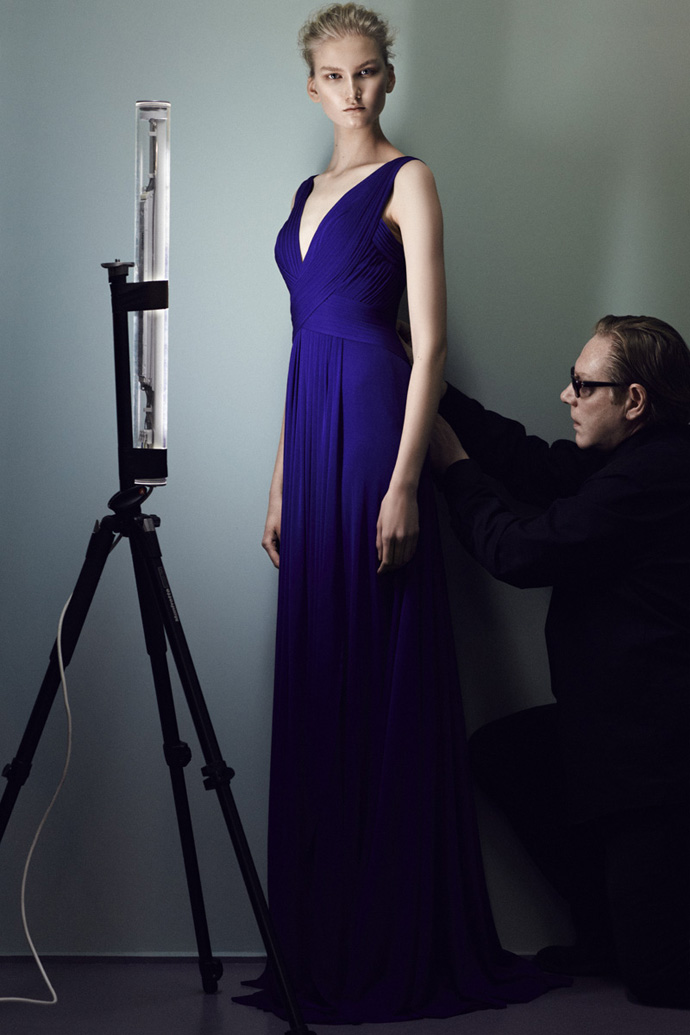
Mr.HL: When I was “Hervé Léger” I was never satisfied. Nothing was good enough and I always thought I could do better. Today, although I still want to do better I become emotional by looking at my own dresses, a feeling I never had before.
I am happier today because I don’t have anybody else involved in my business; I have a great team of loyal people working with me. Also what is very emotional for me is when I see women trying my clothes on.F.M: What is next for you?
Mr.HL: I’m working on developing my business. A perfume that I am working on. I want to start doing accessories, shoes, lingerie and swimsuits. Also my customers locked me in my atelier designing dresses – at least I am famous for something (laughs)- but you know I am very good in designing suits, coats, pants and blouses…Basically when you are wearing Herve L.Leroux, is for the evening. I want to make day-wear too. Although every time I do they never buy it, but I’m going to push.
The interview is a collaboration project between Un nouVeau iDEAL and The Stimuleye.
interview FILEP MOTWARY
photography RENE HABERMACHER
fashion editor SUZANNE VON AICHINGER
hair PANOS PAPANDRIANOS
make up YIANNIS SISKOS
model ANNA MARTYNOVA@ NEXT MODELSthank you VERSAE VANNI @ NEXT PARIS
-

I COULD BE YOURS ! jean-paul lespagnard
-In a joint interview with Caroline Daily, we talk with Yelle collaborator and 2008 Hyères winner Jean-Paul Lespagnard about his first Paris Fashion Week presentation…
I Could Be Yours - Fall/Winter 2011/12 presentation, filmed by Antoine Asseraf & René Habermacher.
Antoine Asseraf: Did your presentation go well this week?
Jean-Paul Lespagnard: It went really well. The feedback is really good. It was very difficult to organize, obviously, but as I always say “we learn from our mistakes”. ha ha. In the beginning I wanted to do something simple and small and in the end, I found myself doing 7 shows in one day! My assistants tell me all the time that when I tell them something, I think that it is really simple, when in fact it isn’t. So when I tell them that we are going to do something difficult, but that we will succeed, they know that it is going to be a mountain of work! But really really happy with how everything went. The people from the press are really enthusiastic. The people that came by the showroom are very enthusiastic too. I had some buyers–one from a boutique in NY, one from a boutique in Hong Kong, among others.
Was it complicated to plan?
It was a personal choice to put myself in the “off” on presentations by appointment. And i think that I will continue to do that. Because, this idea of doing 6 shows in one day was difficult and I launched myself into a crazy adventure, but I really want to do it again. I think its great because people can come whenever they want to. There is something that I like about not having chairs, it was standing only. I think that the next time, what I could do is have little portable stools for people that want to sit down. I just really like the idea of something spontaneous like what we did. So something that I am going to work on and try to perfect for next time. This defilé was meant as a way for me to come back after the festival and to present my work to buyers. When the buyers came to my showroom, they said “its great, its fresh, we have never seen this before, but we are not sure where to place your work for the moment” This is good actually because now, they have 6 months to digest what they say and to think about ideas for where to place my collection and about where my stuff fits in with other designers. I really very very happy with my fashion week in Paris!
(more…)
